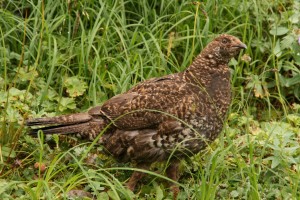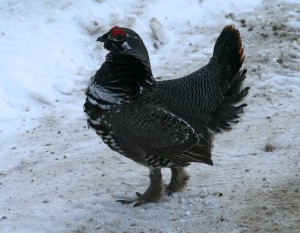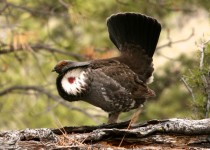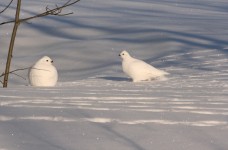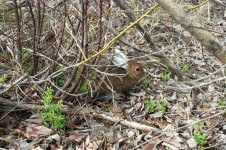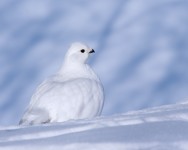A frenzy of flapping bursts from the shrubs no more than 10 feet away, quickening my heartbeat until I realize it’s only a spruce grouse. After landing in a nearby tree, I notice the bright red eye comb of the male. The female is harder to distinguish from other female grouse species because of the overall mottled brown coloration.
The spruce grouse’s cryptic color makes it seemingly impossible to see until you are practically stepping on it and then sometimes it won’t even fly away. Spruce grouse can often be approached extremely close, giving them the name of “fool’s hen” for not flying away and yet they amazingly survive. They supposedly fly away sooner when approached by predators other than people and just as their explosive take-off startles us, it can startle a predator long enough for the grouse to escape to safety. Predators include coyotes, great horned owls, martens, goshawks, fishers, lynx, red-tailed hawks, fox and people.
Spruce grouse can be easy targets for hunters in the fall when they frequent roads, streams and lakesides to ingest small pebbles. The pebbles help grind food in their gizzard, particularly when they switch from their summer diet of berries, leaves, seeds and fungi to their winter diet of fibrous conifer needles.
During the winter, they solely survive on conifer needles, mainly spruce, pine, fir and larch. Their beak is specially adapted to snip off needles which are toxic and bitter to most animals because of chemicals. However, a spruce grouse’s digestive system can handle the chemicals and actually expands in size and length during the winter so that the grouse can digest the larger amount of food needed to survive the long, cold winter nights. The digestive tract grows enough to store up to ten percent of the grouse’s body weight in food. That is like a 150-pound person eating 15 pounds of food before bed every night.
Spruce grouse will fly out of their territory to find pebbles to aid in the digestion of all those conifer needles. Otherwise, they typically stay within their home range of 10 to 25 acres. Unlike blue grouse that group into large multi-family flocks in autumn and winter, spruce grouse tend to be less social. Females and juvenile grouse will form small flocks in winter, but the males are typically alone. The only time male spruce grouse congregate is during autumn when they join a hen and brood before going their own way for winter.
During spring, the males will attract females to mate, but then leave the incubating and rearing to the female. Unlike the adult’s diet of leaves and berries in the summer, spruce grouse chicks will mainly eat insects during their first summer. Then in autumn, conifer needles become the mainstay of their diet.
Despite a stable food source of conifer needles, spruce grouse can be everywhere in a patch of woods one year and the next year hardly one can be found. The reason for the periodic crashes is unknown. Abundant or not, it only takes one spruce grouse to make your heart jump when it bursts from the nearby brush.

